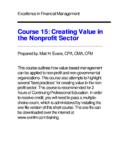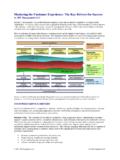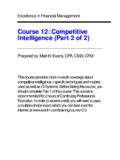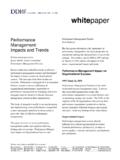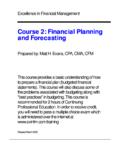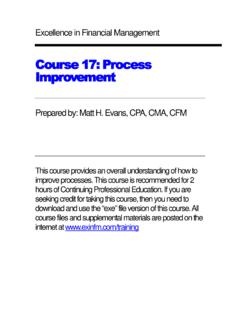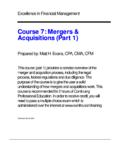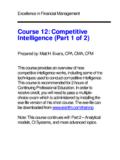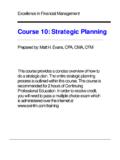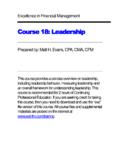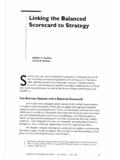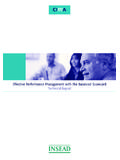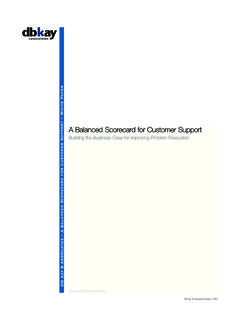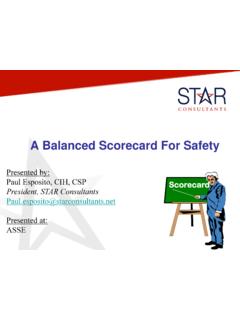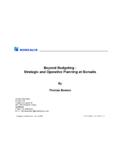Transcription of The Balanced Scorecard - exinfm
1 Course 11: The Balanced Course 11: The Balanced Course 11: The Balanced Course 11: The Balanced Scorecard Scorecard Scorecard Scorecard Prepared by: Matt H. Evans, CPA, CMA, CFM This course provides a step-by-step guide on how to build a Balanced Scorecard . An understanding of strategic planning is recommended prior to taking this course. Refer to Course 10 on strategic planning. This course is recommended for 2 hours of Continuing Professional Education. In order to receive credit, you will need to pass a multiple-choice exam which is administered by installing the exe file version of this short course.
2 The exe file can be downloaded from NOTE: This short course includes the following supplemental materials: - Excel Templates: Set of basic templates for building the Balanced Scorecard - PowerPoint presentation: Outlines overall development steps - Case Study: Short case study on the Balanced Scorecard at UNUM Corporation Supplemental materials are posted on the internet at Revised: February 4, 2002 Excellence in Financial Management 2 Basic Concepts Accountants communicate with financial statements. Engineers communicate with as-built drawings.
3 Architects communicate with physical models. It seems that almost every profession has some means of communicating clearly to the end user. However, for people engaged in strategic planning there has been an on-going dilemma. The finished product, the strategic plan, has not communicated and reached the end user. Sure strategic plans are nice to look at, full of bar charts, nice covers, well written, and professionally prepared; but they simply have not impacted the people who must execute the strategic plan. The end result has been poor execution of the strategic plan throughout the entire organization.
4 And the sad fact of the matter is that execution of the strategic plan is everybody s business, not just upper level management. Upper level management creates the strategy, but execution takes place from the bottom up. So why do strategic plans fail? According to the Balanced Scorecard Collaborative, there are four barriers to strategic implementation: 1. Vision Barrier No one in the organization understands the strategies of the organization. 2. People Barrier Most people have objectives that are not linked to the strategy of the organization.
5 3. Resource Barrier Time, energy, and money are not allocated to those things that are critical to the organization. For example, budgets are not linked to strategy, resulting in wasted resources. 4. Management Barrier Management spends too little time on strategy and too much time on short-term tactical decision-making. Therefore, we need a new way of communicating strategy to the end-user. Enter the Balanced Scorecard . At long last, strategic planners now have a crisp and clear way of communicating strategy. With Balanced scorecards, strategy reaches everyone in a language that makes sense.
6 When strategy is expressed in terms of measurements and targets, the employee can relate to what must happen. This leads to much better execution of strategy. Chapter 1 Only 5% of the workforce understands their company strategy. Only 25% of managers have incentives linked to strategy. 60% of organizations don t link budgets to strategy. 86% of executive teams spend less than one hour per month discussing strategy. Balanced Scorecard Collaborative 3 Not only does the Balanced Scorecard transform how the strategic plan is expressed, but it also pulls everything together.
7 This is the so-called cause and effect relationship or linking of all elements together. For example, if you want strong financial results, you must have great customer service. If you want great customer service, you must have excellent processes in place (such as Customer Relations Management). If you want great processes, you must have the right people, knowledge, and systems (intellectual capital). In the past, many components for implementing a strategic plan have been managed separately, not collectively within one overall management system. As a result, everything has moved in different directions, leading to poor execution of the strategic plan.
8 Like a marching band, everyone needs to move in lockstep behind one overall strategy. Therefore, you should think of the Balanced Scorecard as a management system, not just another performance measurement program. And since strategy is at the center of value-creation for the organization, the Balanced Scorecard has become a critical management system for any organization. In 1997, Harvard Business Review called the Balanced Scorecard one of the most significant business developments of the previous 75 years. Balanced Scorecards provide the framework around which an organization changes through the execution of its strategy.
9 This is accomplished by linking everything together. This is what makes the Balanced Scorecard so different; it captures the cause and effect relationship throughout every part of the organization. In the case of Mobil Oil, the truck driver pulls a Balanced Scorecard off the visor in his cab, outlining the five things he must do as a truck driver. Like a laser beam, strategy now has a clear path to everyone in the organization. Throughout the entire process of building and implementing a Balanced Scorecard , we all need to speak the same language.
10 Therefore, the first thing to get out of the way is to understand a few terms: Balanced Scorecards tell you the knowledge, skills and systems that your employees will need (learning and growth) to innovate and build the right strategic capabilities and efficiencies (internal processes) that deliver specific value to the market (customer) which will eventually lead to higher shareholder value (financial). Having Trouble with Your Strategy? Then Map It by Robert S. Kaplan and DavidP. Norton - Harvard Business Review Terminology 4 Cause Effect Relationship: The natural flow of business performance from a lower level to an upper level within or between perspectives.
